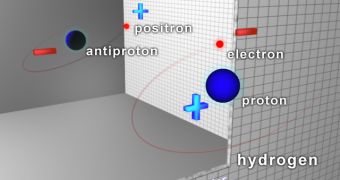We've "known" about antimatter for a long time, but there's still little we actually understand about it. The reason is that it's hard to study something you can't actually get ahold of. There's not much antimatter going round and even if you manage to create some, keeping it stable is no small feat.
Now, scientists have devised a method of cooling antimatter atoms to lower temperature than what's been achieved so far. Cooler atoms are more stable, they survive for longer and are easier to measure.
The method hasn't been put to the test yet, but computer simulations have shown that it should work.
Researchers in the US and Canada plan to cool antihydrogen atoms to about 20 millikelvin, compared to 500 millikelvin which is the lowest achieved so far.
Antimatter has to be cooled to near absolute zero and even then, it's very difficult to keep it together. Antimatter particles are identical in every way to regular particles, but they have an opposite charge.
For example, the positron has a positive charge as opposed to the electron's negative one.
Conversely, the antiproton has a negative charge, compared to the proton's positive one. When opposing matter and antimatter particles collide, they are annihilated and energy is released.
Creating the positrons and antiprotons is hard enough, putting them together is harder and then making sure they survive long enough to study them is harder still.
Complex magnetic fields are used to keep antimatter from colliding with regular matter. Even so, the longest antimatter has been kept alive was 1,000 seconds, about 16 minutes, last year at CERN. It was considered a very impressive feat. It was only in 2012 that the first experiments on antihydrogen atoms were performed.
Scientists hope that this new method of cooling will make it easier to study antihydrogen. As with regular matter, lasers are used to cool antihydrogen atoms to the very low temperatures. However, it's difficult to do this and not interfere with the trapping mechanism which keeps the antimatter from flying around and hitting matter particles.

 14 DAY TRIAL //
14 DAY TRIAL //